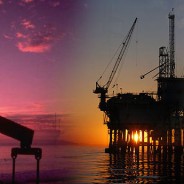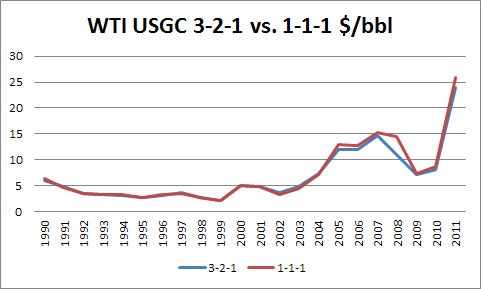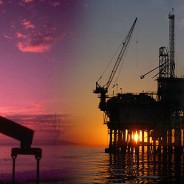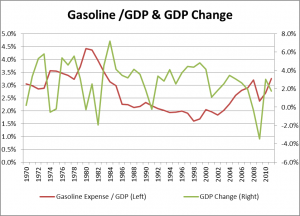Refining Economics Will Be Focused on Simplicity
Refining in the US has been focused on a premise that never came true. The age old belief in refining economics:
1. Crude oil was going to get heavier and higher in sulfur.
2. Gasoline demand would continue to grow and represent a premium of diesel.
Unfortunately for many, those beliefs never transpired. This belief breakdown can be attributed to the strength of the word markets versus US markets. Crude oil prices breaking beyond the historical norm of $20-40/bbl changed the game.
With prices this high, what was once un-economic now has become proven reserves. These new recoverable supply broke the trend of heavier crudes by offer lighter finds. Shale development is leading to an increase in condensates lightening US refiners feedstock.
The quality of condensates also produces yields of more gasoline than diesel. World oil demand is growing from diesel demand, not gasoline demand. Diesel is the premium product. US refiners had geared up to produce gasoline, only to have the product, not offer the value compared to all the expenses refiners put into to produce gasoline. As seen below, simpler refining setup would produce better margins, particularly if one account for fixed and variable expenses.
What does this all mean and where do we go from here: I expect US gasoline demand to continue to fall this year. Diesel will continue to be the premium product. Even though refining margins seem high relative to history, this is the wrong perspective.
With the higher crude oil price paradigm, one needs to look at margins at a percent of feedstock cost. With a cost of $20/bbl one could be satisfied with a $4/bbl return (20%). However at $100/bbl, a $4/bbl really wouldn’t satisfy the risk or cost. The figure below shows the current margins are not high on a historical basis when one accounts for the underlying feedstock cost.
Refiners who will be successful in this environment will be those who can simplify. Lower operating cost will be the key, as added complexity with additional cost offers no value. Hovensa and Valero Aruba refineries both noted they have much higher operating cost than USGC refiners. This is a result of the higher crude oil price world. Refiners who have access to natural gas can save over $2/bbl on operating cost, as fuel oil prices remain de-coupled from the gas markets.
At All Energy Consulting we have put together forecast for our clients. We can use our expertise for margins calculation to developing a crude oil forecast. If you are evaluating a project/investment, I would suggest calling or emailing All Energy Consulting. We can provide an independent analysis along with key solutions to maximize your potential in making a successful project/investment.
Your Energy Consultant,
David K. Bellman
CERAweek 2012 Summary from the Outside
This years CERAweek marks my first year in almost 10 years in not going to CERAweek. I had the privilege to be invited and speak at CERAweek two times. The amazing thing about CERAweek is the shear size. I have seen it grown from the days in the Galleria area to now at the Hilton Convention Center hotel.
One of the values of being at CERAweek, which you cannot get from reading summaries, comes from the time to reacquaint yourself with your fellow energy colleagues. Also, one of things I always marveled at from being at CERAweek is the logistics of the staff to serve meals. When you attend CERAweek, it is not a buffet line – it is a three course meal for lunch and dinner.
In terms of content summary, Platts did a fine job summarizing many key points in their blog. In addition, twitter works out well when you search #CERAweek. The highlights, I believe, were noteworthy:
CERAweek Oil Day:
I have to agree with Iain Conn, group managing director and chief executive of BP’s worldwide refining and marketing group. Mr. Conn said refinery investments will continue happen in the Atlantic Basin, but it will be strategically done. He also specified he expected to see investments in facilities to take the condensates from the shale development and make products. Those who have been reading my blog will note I made that call early February.
A group made of a good aquiantance Marianne Kuh, Chief Economist ConocoPhillips, and my friend Frank Verrastro, senior vice president and program director at CSIS Energy and National Security Program; noted the high crude oil price is more of a function of actual demand growth, not only political uncertainty of Iran. I do agree with these points, but I still think monetary policy has influenced the price of oil as significantly as demand, if not more.
To prove my point, I have pulled annual oil prices, M2 money supply, and oil demand since 1981. I have graphed the information below. I also ran regressions on each of the variables to oil price. M2 money supply has a better R^2 with 0.61 vs. 0.48. Together they produce a rather strong correlation for an R^2 of 0.70. Another interesting outcome of this analysis is it shows for the first time the amount of M2 is now greater than 10% of the world demand expressed in millions of barrels/day. This started in 2009 as the FED aggressively moved to “save” the system.
CERAweek Gas Day:
There were several discussions of natural gas vehicles. I think it’s a clear choice for fleets to convert to natural gas. Mass transit vehicles should move towards CNG. There was discussion on a recent article in the Wall Street Journal by Robert McFarlane, served as President Reagan’s national security adviser from 1983-85. In the article Mr. McFarlane talks about methanol vehicles. Speakers at CERAweek disagreed with him largely on the premise of structural issues. I think the more valid concern would be the history and fate of MTBE. From what I have gathered methanol would be more toxic than MTBE. I do disagree in how we handle the MTBE issue – requiring MTBE then banning it. MTBE was a messenger to a problem that is still happening. MTBE gave you a mechanism to trace and track leaking gasoline. By eliminating MTBE you did not solve the real problem.
Apache CEO, Steven Farris, made remarks in regards to supplying utilities with long-term contracts, but with a floating gas price. Once again I have blogged about this before. It would be worthwhile to continue to watch this evolution. Many are trying to emulate coal contracts, but the reason and the value of contracting gas is not the same as it was with coal.
Of course it wouldn’t be gas day without a deluge of shale discussion and fracking concerns. Many speakers talked about transparency and the efficacy of fracking. I will have to agree here that it can be done in a responsible and safe way. It is a matter of regulators to effectively regulate, because there will always be bad actors.
My former consulting company, Purvin & Gertz, who got acquired by IHS had their own session at CERAweek. They spoke about the NGL markets. Once again I did note about the dynamics of what is going on in this market in my previous blogs. This is an exciting area, full of opportunities.
CERAweek Power Day:
For some reason, the day opened with a discussion of nuclear renaissance. I will have to agree with GE CEO Immelt – there has never been or will be a nuclear renaissance in the US. I will add the caveat – unless significant structural changes are made to our electric industry design. This country has cost-effective options whereas other countries do not (e.g. France, Japan, etc…).
I will have to differ with many of Alstoms thoughts. Alstom has been a very vocal and huge supporter of CERAweek for the past few years. They spoke many times during the conferences. I have read that they still are investing heavily in CCS. They believe the focus for clean energy should be on the technology side. Once again in my blogs, I elude to the point it is not the technology that is limiting “clean” energy; it is the business strategy and incentives. They also point out that gas generation should focus on bigger turbines with lower cost. Of course, that sounds ideal, but I think over the next 3 years the value proposition will be for more dynamic turbines versus bigger and efficient. I say this because of the need to serve the intermittent nature of wind.
FERC commission, Philip D. Moeller, discussed the point that the consumer needed to see the real price. I believe he is trying to point out the desire of real-time metering. However I will disagree with this since there are several ways to make pricing more transparent to the consumer. Rate design in itself does not hide the cost of power, since regulation comes with cost recovery. It is the actors behind the rate design that hide the true cost of power – as noted in my previous blog. Real-time pricing will change consumption, but the bulk of the impact could be done by having block metering – on and off-peak hours with no dynamic pricing, but a statement to the consumer. The hours between 7am-10pm will be more expensive than 10pm-7am. This method would come at a fraction of the cost and involve much less complexity. I do understand the value of the “smart” grid that it comes from other forms, such as reliability; but this is not how it is being sold to the consumer.
I couldn’t agree more with CEO and President Bruce Grewcock of Kiewet – “In a lot of jurisdictions, people are going to see rate shock when they see the true costs.” Once again this is not coming from a smart grid realtime perspective, but the fact that there has been an underinvestment by the utilities. Instead of focusing on true needs over the past years, we have focused on projects and mechanism of style (e.g. CCS, IGCC, fuel deferral, smart grid, etc…). Inefficiency in markets will always come back to haunt you.
We positively and evocatively challenge the current thinking involving any aspect of energy use. We look for projects that offer meaningful, transformative, with impactful outcome to the marketplace or society.
Independent analysis and opinions without a bias right is what we offer to our clients. Please consider and contact All Energy Consulting for your consulting needs.
Your Energy Consultant,
Gasoline Prices Will Impact the Economy
As promised from my last blog, I have a rebuttal for Barclays Capital economists Peter Newland premise, that the key concern is the rise, not the absolute price of gasoline.
“The effect on growth of a rise in energy prices depends importantly on the abruptness of the increase. We found that, given a gradual and temporary rise, consumers are able to adjust saving patterns to smooth consumption, minimizing the impact,”; Peter Newland, an economist at Barclays, said in a recent note.
I do believe consumers will change, but I am not sure whether one would consider these price gyrations not abrupt. To support my claim all one needs to do is to look at the historical retail price changes. The price rise in 2011 was much greater than 2008 price, largely since 2008 had the back end price drop. In terms of all the other years this price change is the greatest price rise since 1980 on a year to year basis.
In terms of consumer behavior change, I believe the extent of consumer change is limited compared to what Peter may believe. The following graph shows that consumers do react in two areas – being more efficient and driving less.
As the cost of gasoline to the consumer increases more rapidly than their disposable income growth in the range of 3% or higher, we see an eventual reaction from the consumer. Howeve, the change in the consumer behavior is very narrow other than in the late 70’s and early 80’s. The largest miles traveled drop was only -1.8% in 2008. Also, I expect the fleet mile per gallon to change more slowly, given the fleet is so large now with over 250 million registered vehicles compared to 1980 of only 161 million. MPG change is a function of the fleet calculation by EPA. I do have the explicit miles traveled divided by the gasoline consumed. The last time that improved by over 2% was back in 1992.
There is no doubt the gasoline prices is dragging the economy. As I have pointed out in many of my blogs, energy is a means to an end. Gasoline is no different. Having all the gasoline without the ability to use it to be productive will do nothing to an economy. Whether one is driving to work or getting goods delivered, the increase in cost will result in a reduction of the economy. There are critical price/expense points. I believe we are likely to cross that point this year. The below graph shows the historical trends of gasoline expense related to the economy.
As the graph shows, as soon as the economy starts spending over 3% on gasoline we see a slowdown in the economy. For 2012 I would expect another year above 3%.
I have spent much of my career analyzing the gasoline markets, given its importance to the US petroleum balance. I have many more graphs and views into the gasoline markets. For 2012, I expect gasoline demand to see the same fate as was observed in 2011.
We positively and evocatively challenge the current thinking involving any aspect of energy use. We look for projects that offer meaningful, transformative, with impactful outcome to the marketplace or society.
Independent analysis and opinions without a bias right is what we offer to our clients. Please consider and contact All Energy Consulting for your consulting needs.
Your Energy Consultant,













